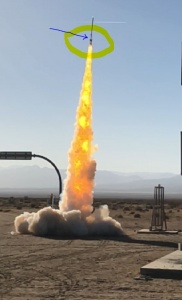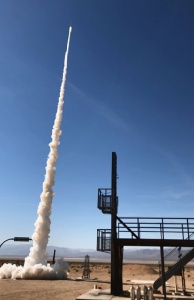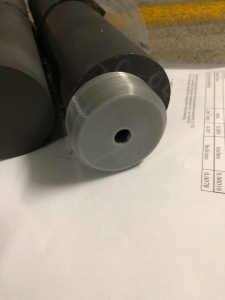The Reaction Research Society (RRS) held another launch event at our private testing site, the Mojave Test Area (MTA), on October 27, 2018. We had a really big day in hosting a launch event for Weigand Elementary School and supporting the projects of several of our members. This was one of the more perfect days for a launch. The day time temperatures stayed below 90 degrees Fahrenheit and the winds were nearly still the whole day.
Our pyro-op for the event was John Newman, of the Friends of Amateur Rocketry (FAR) group.
Friends of Amateur Rocketry – webpage
John allowed myself, Dave Nordling, and Larry Hoffing apprentice under him for the event as we are both in training to become licensed pyrotechnic operators in California.

John Newman (right) from Friends of Amateur Rocketry (FAR) talks with Mr. Oswald (left) and Dr. Kasparian (middle) at the RRS MTA, 10/27/2018

John Newman (left, behind the wall) and Larry Hoffing (right) oversee the loading of micrograin propellant at the RRS MTA
The RRS welcomed Weigand Elementary School and the Los Angeles Police Department’s (LAPD) Community Service Program (CSP). They had just finished the six session program and had ten (10) alphas ready to launch.
RRS member, Michael Lunny, had come out to the MTA the week before to help Osvaldo with mixing of the micrograin propellant. The simple mixture of zinc and sulfur powders is relatively safe, but requires time to properly mix and load. With the larger demand for alpha rockets with school projects and our growing membership, it’s no longer a process that can be done in the early morning hours before launch day.

Osvaldo Tarditti and Michael Lunny at the RRS MTA, 10/27/2018, having done the hard work of loading the rockets the week before

The ten alphas from Weigand Elementary and Michael Lunny’s alpha in white, all loaded, tagged and ready to go
RRS member Alastair Martin was at our event doing a great job in video-recording many aspects of our event. Alastair and Bill Janczewski, both newly elected to the position of Media Coordinator at the RRS, have been helping expand the presence of the RRS in social media and to the public at large.
Alastair got a lot of great shots and video-footage which I’ll share as they come in. Some of the short videos and photos from the 2018-10-27 event are already posted on the RRS Instagram page.
Follow the RRS on Instagram – ReactionResearchSociety
Just before the briefing, two of our new members had the chance to experience loading their own alpha rockets with the micrograin propellant. Xavier Marshall and Wilbur Owens were coached in the process and got a first-hand feel for classic micrograin rocketry. Michael Lunny’s alpha rocket was already set to go the week before when he helped Osvaldo load the ten alphas for Weigand Elementary.

Wilbur Owens loads his alpha rocket, one cupful at a time, gently bouncing out the air pockets as he goes

Once the alpha propellant tube is full of propellant up to the bolt holes, Xavier Marshall prepares to install his nozzle with the electric match and burst disk which retains the powdered propellant inside

A close-up view of the alpha nozzle with its plastic burst-disk and electric match resting on the interior side, the electric match wires protrude out the bottom (held back by carpenter’s tape just for convenience)
[SAFETY BRIEFING]
We conducted our safety briefing at the beginning of the event before all present. We discussed the many natural and man-made hazards to help everyone become aware and be more safe. John Newman made us aware of a native species of snake, the Mojave Green Rattlesnake, which is sometimes known to become aggressive when discovered. The Wikipedia page is linked below.
Mojave Green Rattlesnake – Wikipedia
Frank also reminded everyone about keeping their distance from the Desert Tortoise, which is a federally protected species that is also indigenous to the Mojave desert and the MTA. It isn’t very common to see these animals during the height of the day, but everyone needs to be aware and take heed of their surroundings to protect themselves and the environment.
Desert Tortoise – Wikipedia page
Besides avoiding heat exhaustion and spiders, collecting and properly disposing of trash, and maintaining their hydration, all attendees must remain under the cover of our reinforced bunker during hazardous operations. With the conclusion of the briefing, we proceeded to a propellant demonstration to show the combustion process on a sample of composite propellant and micrograin powder.

Small sample of composite grain propellant burns hot enough to cut through the steel case supporting it, slow burning but very potent

The bright yellow plume of burning micrograin propellant, zinc and sulfur together go up pretty fast
The next step was getting everyone into the bunker, while John Newman conducted the event as our pyro-op. Larry and I were on hand to assist in the loading and readiness for firing. The RRS alpha had a steel box frame launcher which is our preferred method of guiding these speedy metal rockets up and downrange west.
We got started loading them into the rack by the numbers. The kids did a great job of painting them and making them their own. Most importantly, they label them with large numbers. The color of the fins matter the most since that is the only part left sticking out of the ground at the end of flight.
After launching all ten of the rockets, we all took our lunch break. The day was very pleasant, but we all enjoyed a little bit of shade. After lunch, LAPD CSP packed everyone up for the long drive to Los Angeles.
[MEMBER PROJECTS]
We started working on membership projects starting with launching Michael’s alpha. It’s always rewarding to launch your first alpha and it’s an experience that never gets old. It’s usually one in a series to come. Big thanks to Michael for helping the society get ready for the event.
Xavier Marshall tried a new approach to launch by allowing me to use the fly-away railguide that I had customized for the 1.25″ RRS alpha propellant tube. Additive Aerospace makes many standard models which this one was derived from the 38 mm design.
Additive Aerospace – fly-away rail guides
The first rail launch of an RRS standard alpha was successful. The flyaway railguide seemed to hold as the micrograin rocket sped off the rails. We took video from the facing side of the rail to get a better look at the operation. I was able to get one good still from my camera phone video from the blockhouse. You can see the railguide just above the fins as the rocket has cleared the rails so the flyaway railguide has sprung open and now is free to tumble away.

Xavier’s rail launched alpha rocket makes a clean path up the 20-foot guide, rail guide still seen near the rocket just after clearing the rail
The railguide fit to the alpha very well but the rail buttons were a little sticky as the rocket was slipped into place. I think the dusty aluminum rail is more to blame for this. The workmanship on these flyaway railguides from Additive Aerospace is quite good. Flying one of these devices with a micrograin rocket was expected to be challenging given the high acceleration that micrograin rockets are known for.
The railguide was not recovered intact. I recovered most of the pieces and the plastic end pieces showed fractures. It’s not clear if the railguide broke on the ground from the fall, but given the spread of the pieces, it could be possible the sudden acceleration of the RRS alpha fractured the lower clamp as the rocket took off. Review of Alastair’s video in slow motion may answer what the failure mode is. All pieces were recovered within 50 feet of the rail.

The recovered pieces of the flyaway rail guide. A successful launch but the mechanism didn’t survive for more than one attempt.
Jack Oswald and his team had a set of sample end-burner motors with their next batch of propellant for burn-rate testing. After setting up the first motor, a key part was missing and the pressure transducer had to be mounted too close to the exit plume. It was expected that the pressure transducer wouldn’t survive the first burn but the test was expected to take good data. The test was executed, but unfortunately the test over-pressurized due to the grain separating from its liner during the initial startup. A lot was learned but the other motors were not able to be tested.
My last photo taken of that day was the last of the three member alphas sitting in the box rails ready to go. Wilbur Owens had the honor of flying his first alpha rocket at sunset.
With the last of our thirteen alphas flying out, we proceeded with the first firing of the horizontal thrust stand built to test loaded alpha propellant tubes. Osvaldo made some modifications to my stout steel frame adapted to the concrete slab in front of the old RRS blockhouse. Dave Crisalli poured this concrete slab as a working platform in the 1970’s. USC in recent times drilled the slab with 1/2″ female anchor bolts to test small 50-lbf motors. It made sense to use this existing foundation for our horizontal thrust stand.

Osvaldo uses his 185 lbf son, Matteo, as a quick load cell calibration check as Jack Oswald observes the 1124-lbf ranged load cell output on the laptop in the blockhouse. Awkward, but effective.
After some initial software and operator problems with getting and keeping the S-type load cell calibrated, the system was ready to go.
It has been MANY years since the RRS had made direct impulse measurements of an RRS alpha micrograin rocket, but we felt this hardware would be useful for other similar projects in our near future. Although horizontal testing of a micrograin rocket is not indicative of the actual vertical flight, we felt we could still learn much from this testing.

A simple bottle jack (commonly used for changing an automobile tire) was used as a load cell calibration device (pressure gauge was damaged in handling)
We retreated to the blockhouse and got the testing underway. After two false starts from the bunker, we got the alpha motor to fire in the horizontal position and captured it on video.
The results were good in that the load cell readings were captured and the structure adequately retained the rocket in its very brief (0.4 second) thrust bit. Osvaldo crunched the numbers from the readings we got from the test. Load cell readings indicated we reached a peak thrust of 544 lbf. Burn time was only 0.4 seconds.

This is the raw data from the alpha firing in the (translating) horizontal thrust stand; we need more data
The RRS is very grateful to Interface Force Inc. of Arizona for their generous donation of the S-type load cell we’re using.
These devices are not very expensive ($350?? each) and are available in sizes from just 100 lbf to up to several thousand pounds. Button cells are more compact and also work well, but they tend to be more expensive.
The big surprise was that our concrete pad wasn’t as well secured as we had hoped. The pad was only 6 inches thick which means that the slab was only an inch or so beneath the surface. I do recall being told this slab poured by RRS member, Dave Crisalli, in the 1970’s, was only intended to be a working surface and that it wasn’t very deep. USC in recent times had drilled the pad with 1/2″ female anchor bolts for a small 50-lbf.

The concrete slab held fast initially, but suddenly broke free displacing itself by over half its length.
Another observation was that we get a little bit of gas leakage at the end of the burn at the bulkhead. This has been seen in other alpha flight videos and thus it wasn’t a surprise.

Despite the moving target of the whole stand moving, just after the alpha fires, you can see gas leakage at the bulkhead
Osvaldo did not see any damage to the seals when we disassembled the rocket from the stand. This may be a weakness of the seal design but it doesn’t seem to harm performance. More experimentation will shed light on this.
Check out the RRS Instagram page to see this footage. I’ll be uploading it to our YouTube page soon as Instagram has a 60-second time limit for video.
While we were conducting test operations at the MTA, Wilbur Owens located his rocket downrange and started the laborious process of alpha recovery by shovel. Osvaldo’s extractor tool has made short work of this step, but I don’t know if it was available that day?
[PROPELLANT DISPOSAL OPERATIONS]
Jack and his team had a quantity of unspent composite propellant which had to be properly disposed. He had quite a bit from a failed attempt to cast a previous motor that hardened too quickly. The RRS MTA is a good place to do this. With the low winds, we are able to safely touch off the two batches in the waning hours of the day.
The first burn was the smaller of the two. The sun had already set so we were losing the light fast.
With the light almost gone, the second batch lit up the night just for a brief moment before fading.

The second propellant disposal burn at its brightest, but quickly fades as the burn safely completes
[IN CONCLUSION … THINGS COMING UP]
Frank had said that the LAPD CSP is looking to start the next school program in January of 2019. We are very grateful to the LAPD CSP for their continuous support to our classes. The RRS is proud to help the community by sharing the hobby we love.
As mentioned in our last monthly meeting, the next event with the RRS will be our visit to Chapter 96 of the Experimental Aircraft Association (EAA). RRS members, Xavier Marshall and Wilbur Owens, invited the RRS membership to join them at their hangar at the Compton Airport on Saturday morning, November 3rd, at 10:00 AM. The RRS is interested in getting inexpensive shop space that is reasonably convenient to our membership residing in the Los Angeles area. The RRS is looking to help cultivate practical machining skills such as lathe work and milling. Many of our members already have these skills to some degree, but want to help other members become more adept at making their own nozzles, nosecones and other rocket parts.
The next RRS meeting will be November 9th at 7:30PM at the Ken Nakaoka Community Center in Gardena, California. We hope to have Jack Oswald and his team present their results. Despite the failure of the first and only sample hot-firing a great deal was learned which will make the next set of tests more likely to succeed.


















































